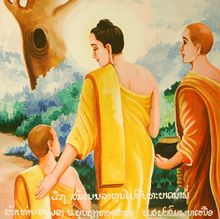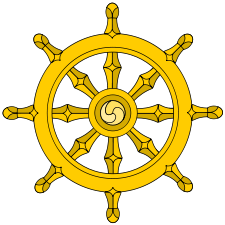Rāhula
| Venerable Rahula | |
|---|---|
 Buddha with Rahula. |
|
| Religious career | |
| Teacher | Gautama Buddha |
| Part of a series on Buddhism
|
|
History |
| Dharma or Concepts Four Noble Truths |
| Practices Three Jewels |
|
Nirvāṇa |
|
Traditions · Canons |
|
Countries and Regions |
|
Related topics |
Rāhula (born c. 534 BC) was the only son of Siddhartha Gautama (Pāli Siddhattha Gotama), later known as the Buddha, and his wife Princess Yasodharā.
Accounts of his life differ in certain points. The following is that given in the Pāli Canon.
Contents |
Life

Prince Siddhartha was deep in contemplation, considering the condition of life and suffering and was preparing himself to leave the palace and seek Enlightenment not just for his own sake, but for the sake of all beings. One account claims that when he received the news of his son's birth he replied Rāhu jāto, bandhanam jātam — "A rāhu is born, a fetter has arisen." Accordingly the child was named Rāhula, meaning "fetter", or "chain", recognizing that the child could be a tie that bound him to his wife Yashodhara and the comforts of the life of a householder. However, rāhu does not mean fetter.[1] The second account, found in the Mūlasarvāstivāda vinaya, is that Rahula received his name in accordance with an eclipse of the moon, caused by the snake Rahu.[2]
In the Dhammapada, the pleasure and joy that a man receives in his wife and children is called a "soft fetter" that ties individuals to life and suffering, not just through eventual loss and separation of loved ones but more deeply and subtly may act as ties to cyclic existence (samsara).
Rāhula was raised by his mother and grandfather, King Suddhodana. When he was seven years old, the Buddha returned to his home city of Kapilavatthu at the request of his father who missed him dearly. On the seventh day of his return, Yasodharā took Rāhula to see his father, the Buddha. She told Rāhula that since his father had renounced the palace life and as he was the next royal prince in line, he should ask his father for his inheritance of crown and treasure for his future sake when his grandfather would no longer rule the kingdom.
After the meal, Rāhula followed the Buddha, saying "Give me my inheritance." Nobody tried to stop him, nor did the Buddha prevent him from following him. He then looked at his father and said, "Lord, even your shadow is pleasing to me."
Reaching the Park of Nigrodha, where the Buddha was staying, the Buddha thought to himself: "He desires his father's inheritance, but it is wrought with troubles. I shall give him the benefit of my spiritual Enlightenment and make him an owner of a transcendental inheritance."
The Buddha called Venerable Sariputta and asked him to ordain little Rāhula who became the first Sāmanera (novice monk).
"The King, discovering that now his grandson and a number of young men in the royal family had requested ordination, asked the Buddha only to ordain a minor with the consent of his parents or guardian. The Buddha assented. This rule was expanded to include the spouses of those intending to join the Order of monks and nuns.[3]
Shortly after Rahula's ordination the Buddha taught him the importance of telling the truth. This discourse is known as the Rahulovada Sutta [4]. The Buddha placed truth as the highest of all virtues. The seekers of Truth, (those who have as their goal Nibbana) should not break the precept of Truth.
Rāhula subsequently became one among the many arhants through following the Buddha's teachings.
Rahula died before the Buddha, Sariputta and Moggallana.
Other accounts
In the Mūlasarvāstivāda-vinaya, used by Tibetan Buddhists, it is claimed that Rahula was conceived on the evening of the Renunciation, and born six years later, on the day that his father achieved Enlightenment (which is also said to coincide with a lunar eclipse).
Footnotes
- ↑ Edward Joseph Thomas, The Life of Buddha as Legend and History. Routledge, 1975. Page 53, note 1.
- ↑ Raniero Gnoli (ed.) The Gilgit Manuscript of the Samghabhedavastu. Rome: Instituto Italiano per il Medio ed Estremo Oriente, 1977. 1:119.
- ↑ see section: THE BUDDHA'S SON
- ↑ Ambalatthika-rahulovada Sutta
External links
Buddha's Instructions to Rahula
- Ambalatthika-rahulovada Sutta - Instructions to Rahula at Mango Stone
- Maha-Rahulovada Sutta - The Greater Exhortation to Rahula
- Cula-Rahulovada Sutta - The Shorter Exposition to Rahula
Lifestory
- IMMEDIATE FAMILY OF THE BUDDHA, 5. Rahula by Radhika Abeysekera
Theragatha
Bibliography
- The Buddha and His Teaching, Nārada, Buddhist Missionary Society, Kuala Lumpur, Malaysia, 1988, ISBN 967-9920-44-5
|
|||||||||||||||||||||||||||||||||||||||||||||||||||||||||||
